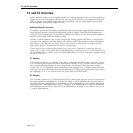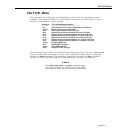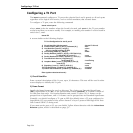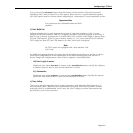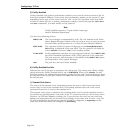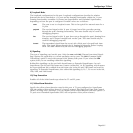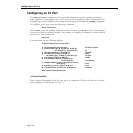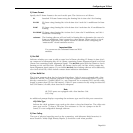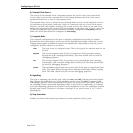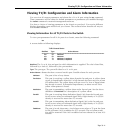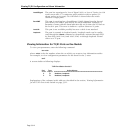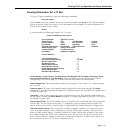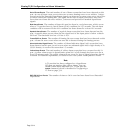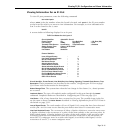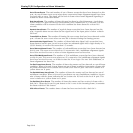
Configuring an E1 Port
Page 33-9
2) Frame Format
Specify the E1 frame format to be used on this port. The choices are as follows:
E1 Standard E1 frame format using the framing bits in time slot 0 for framing.
E1-CRC E1 frame using framing bits in both time slot 0 and CRC-4 multiframe for fram-
ing.
E1-MF E1 frame using framing bits in both time slot 0 and time slot 16 multiframe for
framing.
E1-CRC-MF E1 frame using framing bits in time slot 0, time slot 16 multiframe, and CRC-4
multiframe for framing.
unframed The framing software will not look for framing bits to determine the start of a
frame or multiframe. Data is treated as a data stream. When used in a circuit
emulation application, this option should be chosen when configuring an
“unstructured” circuit emulation service.
Important Note
You cannot use the unframed format on WAN
modules.
3) Not FAS
Indicates whether you want to add an extra level of frame checking. E1 frames in time slot 0
are composed of alternating bits of
FAS (Frame containing Frame Alignment Signal) and NFAS
(Frame not containing Frame Alignment Signal). The Not FAS option tells the framer to check
framing on FAS and NFAS bits. Normally, the framer checks only FAS bits, which contain the
frame alignment signal pattern. If you enable Not FAS, then framing software will additionally
also check NFAS bits, which include remote alarm indication information.
4) Line Build Out
The
E1 port supports short haul or long haul interfaces. Only E1 ports equipped with a Line
Interface Unit (LIU) chip support long haul. Long haul support is necessary if this E1 port is
directly connected to a Central Office (i.e., not connected via an external CSU) and the cable
length is greater than 655 feet (200 meters). If this E1 port connects locally using less than 665
feet (200 meters) of cable, then short haul is adequate.
Note
All T1/E1 ports are equipped with a Line Interface Unit
(LIU) chip.
An additional prompt displays requesting the resistance type used for this port connection.
40) Cable Type
Indicate the cable resistance type used on the short or long haul interface. The cable resis-
tance type can be 75 ohm or 120 ohm. The resistance is a set via a jumper on the E1
board; it is not configurable through software.
5) Line Coding
The type of physical encoding used on the connection.
AMI (Alternate Mark Inversion) is
more sensitive. HDB3 (High Density Bipolar 3) should be used when possible.




